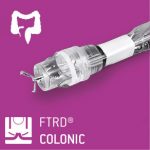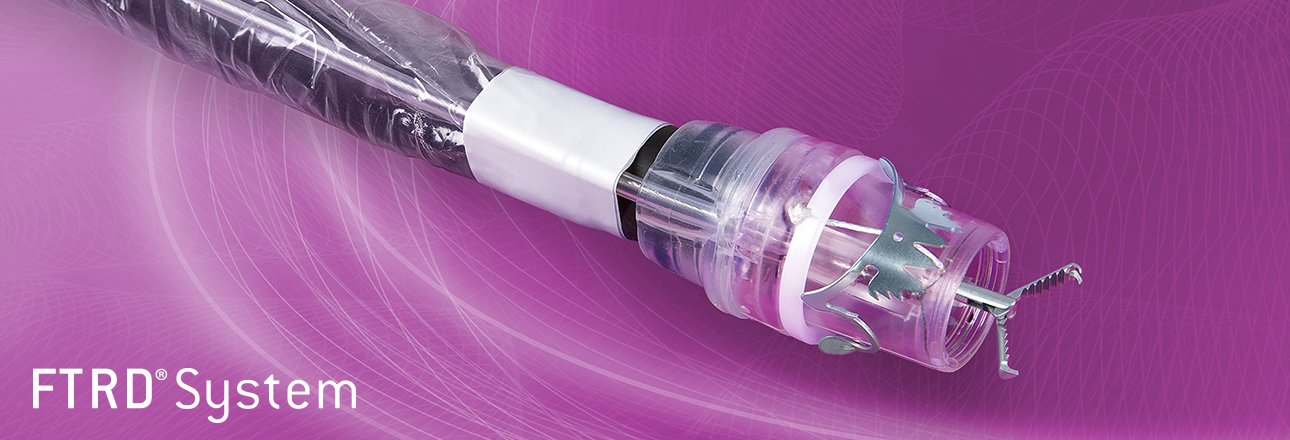65 consecutive patients underwent EFTR of colorectal lesions, either via stand-alone EFTR (lesions <2 cm in size but not amenable to standard EMR; n = 38 lesions) or hybrid technique combining EMR and EFTR (lesions > 2cm; n = 31 lesions). Clinical success (91 %), technical success (83 %) and R0 resection rate (81 %) did not differ between the groups. Three adverse events occurred including two patients developing an acute appendicitis.
S. Mahadev et al., New York University Langone Health, New York, NY, USA performed a single-center retrospective study of consecutive patients with colorectal lesions unresectable by conventional EMR alone, that were treated via stand-alone EFTR with the FTRD System or using a hybrid technique combining the use of EMR and EFTR.
For lesions less than 2 cm in size but not amenable to EMR alone, EFTR was performed as a stand-alone procedure. For lesions larger than 2 cm, EMR was performed initially as part of a hybrid procedure with consecutive EFTR. The intention of the EMR procedure was to remove the lateral spreading component of the lesion in order to reduce tissue volume. Consecutive EFTR would then remove fixed parts of the lesion and parts suspected of high-grade dysplasia or cancer.
38 stand-alone EFTR treatments and 31 hybrid treatments were performed in 65 patients (61 % male, average age 70 years, range 50-90 years). The most common indications were non-lifting polyps (43 %) and suspected high-grade dysplasia or carcinoma (38 %). The lesion size was significantly larger for hybrid EMR + EFTR (mean 39 mm, range 15-70 mm) than for stand-alone EFTR (mean 17 mm, range 7-25 mm, p<0.01). Prior resection had been attempted in 20 cases (29 %), 13 in the stand-alone group (34 %) and 7 in the hybrid group (23 %).
Clinical success (91 %), technical success (83 %), and R0 resection rates (81 %) did not differ between stand-alone and hybrid groups. One reason for technical failure was inability to advance the FTRD through the colon to the target lesion, which occurred in 6 % (4 of 69 procedures). In 2 patients in whom the initial attempt to reach the target lesion was unsuccessful, a second attempt 1 to 3 months later was successful. Other reasons for technical failure were inability to pull tissue into the cap with grasping forceps (2 cases) tissue slippage out of the snare before resection (3 cases), and snare breakage (2 cases). In these cases the neoplastic tissue could be removed subsequently using hot snare and hot biopsy forceps. These events were considered technical failures for the purposes of the study, even if complete resection of neoplasia was achieved for clinical success.
96 % of patients were discharged home on the day of intervention. Three adverse events occurred, including 2 patients who developed acute appendicitis, and one patient with a transmural perforation due to improper deployment of the FTRD which could be successfully closed endoscopically.
The authors concluded that a hybrid approach combining the use of EMR and EFTR maintains safety and efficacy while permitting the resection of significantly larger lesions than FTRD alone.
Outcomes of hybrid technique using endoscopic mucosal resection and endoscopic full-thickness resection for polyps not amenable to standard techniques (with video)
Mahadev S, Vareedayah AA, Yuen S, Yuen W, Koller KA, Haber GB.
Gastrointest Endosc https://doi.org/10.1016/j.gie.2021.02.009
 |
 |


 Deutsch
Deutsch  Français
Français 